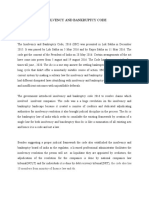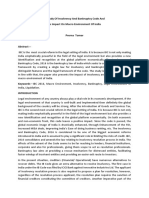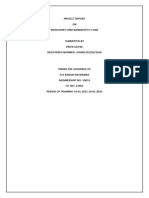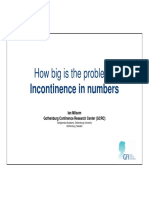0% found this document useful (0 votes)
19 views5 pagesIntroduction
The Insolvency and Bankruptcy Code (IBC) of 2016 was enacted to address India's fragmented and inefficient insolvency regime, which was marked by prolonged debt recovery and rising non-performing assets. It consolidates various laws into a comprehensive framework that emphasizes a creditor-in-control model, timely resolution, and the establishment of a professional ecosystem for insolvency management. Despite its positive impact on India's credit ecosystem, the IBC has faced criticism for procedural inefficiencies and delays, which were further exacerbated by the COVID-19 pandemic.
Uploaded by
Kirit SinghaniaCopyright
© © All Rights Reserved
We take content rights seriously. If you suspect this is your content, claim it here.
Available Formats
Download as DOCX, PDF, TXT or read online on Scribd
0% found this document useful (0 votes)
19 views5 pagesIntroduction
The Insolvency and Bankruptcy Code (IBC) of 2016 was enacted to address India's fragmented and inefficient insolvency regime, which was marked by prolonged debt recovery and rising non-performing assets. It consolidates various laws into a comprehensive framework that emphasizes a creditor-in-control model, timely resolution, and the establishment of a professional ecosystem for insolvency management. Despite its positive impact on India's credit ecosystem, the IBC has faced criticism for procedural inefficiencies and delays, which were further exacerbated by the COVID-19 pandemic.
Uploaded by
Kirit SinghaniaCopyright
© © All Rights Reserved
We take content rights seriously. If you suspect this is your content, claim it here.
Available Formats
Download as DOCX, PDF, TXT or read online on Scribd
/ 5





































































































